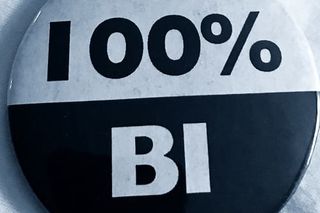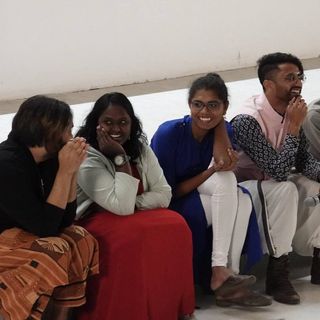
What People Get Wrong About Bisexuality
It’s a thing, I promise.

The B in LGBTQ+ has long been invisible, erased, and maligned, both within the queer community and outside of it. People who identify as bisexual experience attraction to or have had sexual contact with people of more than one gender. However, misconceptions about bisexuals abound, from the ‘they’re just confused’ statements, to the idea that they’d be more likely to cheat on a partner, and the overarching argument that bisexual people don’t actually exist at all — they’re either gay, straight, or lying.
The consequences of these assumptions have a real, quantifiable impact on the mental and physical wellbeing of bi folks. A brief from the Human Rights Campaign showed that bi people face “minority stress,” commonly experienced by stigmatized groups, and have a higher risk of self-harm and attempted suicide than their gay, lesbian, or heterosexual counterparts. The stigma around being bisexual often stops people from coming out, seeking help, and exploring their sexuality. So, let’s parse through what these misconceptions really are, and what we’re getting wrong about bisexuality.
Myth: There’s no such thing as bisexuality.
Reality: More and more, we’re coming to understand sexuality and gender as fluid concepts. The idea that someone must either be attracted to one sex or the other assumes that our preferences are rigid and permanent. So, why put bi people in a box?
Related on The Swaddle:
Gender and Sexuality Terms: A Sensitive Glossary
While it’s ridiculous that this needs to be said, studies have confirmed that bisexuals exist. Researchers from Northwestern University tested straight, gay, and bisexual men by exposing them to various erotic film clips and measuring their physiological responses, proving that people aren’t ‘just hiding that they’re gay’ or lying about their sexuality when they identify as bisexual. They really are attracted to people of more than one gender. (Of course, if we’re only going to use sexual stimulation as a marker of sexual orientation, a study also found that ‘straight’ women showed signs of physiological arousal when exposed to clips of masturbation, lesbian sex, bonobo chimps — everything except naked men. Hmmm.)
Myth: Only women are bisexual.
Reality: Women are not more naturally predisposed to identifying as bisexual. Rather, the lack of bisexual men who are open about their sexuality is due to the stigma attached to it. Our culture of toxic masculinity doesn’t allow men to explore their sexuality, whereas women have arguably more leeway, since their relationships with each other aren’t seen as a threat to their femininity in the way that such male friendships threaten ‘manliness.’
While 7% of gay men and 4% of lesbians reported that they were not out at work, 49% of bi men said they didn’t feel comfortable coming out, according to the LGBT in Britain – Work Report by Stonewall, an LGBT rights charity based in the UK. Bisexual men are also at a disproportionately higher risk of contracting HIV and other sexually transmitted infections, because stigma and erasure make them less likely to seek medical care. The idea that only women are bisexual, a la some sort of Katy Perry music video fantasy, is not only ridiculous, but also actively harms the health and wellbeing of bisexual men.
Myth: Bisexual people can’t be monogamous/ will cheat on their partners.
Reality: The assumption that bisexual people are attracted to more than one gender and, therefore, won’t be able to stay in a monogamous relationship, or will cheat on their partners, just isn’t true. A 10-year longitudinal study, published in Developmental Psychology, found that 89% of the bisexual women studied were in long-term, monogamous relationships. The mere fact that someone is attracted to men, women, and gender non-conforming people, doesn’t mean they’re more likely to cheat or sleep with someone else; neither does it mean they’ll always be faithful. The likelihood that a bi person will cheat on a partner is the same as a straight person — it depends on the individual.
Myth: Bisexuals are transphobic.
Reality: Being bisexual doesn’t imply that a person is only attracted to two genders, it simply means that a person isn’t only attracted to the opposite gender. People might assume that bisexuals subscribe to the gender binary of either man or woman, but in actuality, bisexuals may be attracted to cis people, non-binary, gender non-conforming, and trans folks as well. In order to clarify this, people may also use the term ‘bi+’ to indicate that they’re attracted to more than just two genders.
Myth: Bisexuals face less stigma.
Reality: Bisexual people, if in a relationship with someone of the opposite gender, have the ability to ‘pass’ as heterosexuals. Because of this, they’re often told that they face less stigma than a queer person, who often has no choice but to be out about their identity in order to have a relationship. And data from the Pew Research Centre shows that 84% of self-identified bisexuals are in a relationship with someone of the opposite gender. But this isn’t a cop out — it might be more likely for bi folks to find straight partners, because they are the majority of the population.
However, being with a heterosexual person does not invalidate a bisexual person’s sexuality. And the risks have been well documented — bi people are at higher risks for experiencing mental health issues like anxiety, depression, substance abuse, as well as heart disease, cancer, and STIs. This is directly because of the stigma and simultaneous erasure and invisibility that they face. And if we don’t start combatting some of our assumptions, bi folks will continue to be affected by them.
These misconceptions about bisexuality are directly impacting people’s mental and physical health, causing them to feel isolated and delegitimizing an integral part of their identity. Only when we start breaking down these myths for what they really are — myths — can we begin the work of reversing the years of bi-erasure and fully accepting the B in LGBTQ+.
Nadia Nooreyezdan is The Swaddle's culture editor. Since graduating from Columbia Journalism School, she spends her time thinking about aliens, cyborgs, and social justice sci-fi. She's also working on a memoir about her family's journey from Iran to India.
Related


How Caste Has Always Shaped Desire, Desirability
